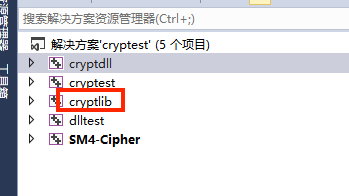唔,美国压制得越狠,各种替代产品就越能活。
本文分享SM4的一种快速实现与集成方式。
SM4(原名SMS4)是中华人民共和国政府采用的一种分组密码标准,由国家密码管理局于2012年3月21日发布[1][2],相关标准为“GM/T 0002-2012《SM4分组密码算法》(原SMS4分组密码算法)”[1]。2016年8月,成为中国国家密码标准(GB/T 32907-2016)[3]。在商用密码体系中,SM4主要用于数据加密,其算法公开,分组长度与密钥长度均为128bit,加密算法与密钥扩展算法都采用32轮非线性迭代结构,S盒为固定的8比特输入8比特输出[4][5]。
是密码界大神wangxiaoyun(让美国安全部颤抖的人)提供的。
主要对标的是对称加密里面的DES与AES。
安全性被大机构验证过,是目前最好的国产对称加密方案。
废话不多话了,既然搜到了本文,肯定是想着怎么实现的。
首先,GMSSL 应该是实现最完整的,啥算法基本都有,但比较大。简单得了解下放弃了。感兴趣的可以自己看http://gmssl.org/。
本人对Crypto++之前有接触,使用过他提供的AES加密方式,搜了下官网,发现从6.0开始便支持SM4了,太好了。
https://www.cryptopp.com/docs/ref/class_s_m4.html#details 这里可以查看详细信息。
本人下载了最新版本8.2的。解压之后打开VS2013,对lib库进行编译,会有个cryptlib.lib的输出。我们只需要这个库即可。

我添加了下测试项目SM4-Cipher进行测试与验证。 验证是通过在线平台看看是否一致。http://aks.jd.com/tools/sec/
直接上代码了。
#include <windows.h> #include <string> #include <iostream> #include "modes.h" #include "filters.h" #include "base64.h" #include "aes.h" #include "sm4.h" using namespace std; using namespace CryptoPP; std::string base64_encrypt(const std::string& src) { //byte decoded[] = { 0xFF, 0xEE, 0xDD, 0xCC, 0xBB, 0xAA, 0x99, 0x88, 0x77, 0x66, 0x55, 0x44, 0x33, 0x22, 0x11, 0x00 }; std::string encoded; try { StringSource ss(src, true, new Base64Encoder( new StringSink(encoded), false ) // Base64Encoder ); // StringSource return encoded; } catch (...) { } return encoded; } std::string base64_decrypt(const std::string& src) { std::string decoded; try { StringSource ss(src, true, new Base64Decoder( new StringSink(decoded) ) // Base64Decoder ); // StringSource return decoded; } catch (...) { } return decoded; } //typedef unsigned char byte; static CryptoPP::byte AES_KEY[] = "1234567890111111"; static CryptoPP::byte AES_IV[] = "1234567890111111"; //这里封装下sm4 加密算法加解密 bool sm4_encrypt(void* data, size_t size, std::string& out) { out.clear(); try { ECB_Mode<SM4>::Encryption cbcEncryption(AES_KEY, 16); StreamTransformationFilter stfEncryptor(cbcEncryption, new CryptoPP::StringSink(out)); stfEncryptor.Put(reinterpret_cast<const unsigned char*>(data), size); stfEncryptor.MessageEnd(); } catch (...) { return false; } return true; } bool sm4_decrypt(void* data, int size, std::string& out) { out.clear(); try { ECB_Mode<SM4>::Decryption cbcDecryption(AES_KEY, 16); StreamTransformationFilter stfEncryptor(cbcDecryption, new CryptoPP::StringSink(out)); stfEncryptor.Put(reinterpret_cast<const unsigned char*>(data), size); stfEncryptor.MessageEnd(); } catch (...) { return false; } return true; } std::string aes_encrypt(const char* src, const int &length,std::string& out) { // try { AES::Encryption aesEncryption(AES_KEY, 16); CBC_Mode_ExternalCipher::Encryption cbcEncryption(aesEncryption, AES_IV); StreamTransformationFilter stfEncryptor(cbcEncryption, new CryptoPP::StringSink(out)); stfEncryptor.Put(reinterpret_cast<const unsigned char*>(src), length); stfEncryptor.MessageEnd(); return out; } catch (...) { } return out; } std::string aes_decrypt(const char* src, const int &length, std::string& out) { try { AES::Decryption aesDecryption(AES_KEY, 16); CBC_Mode_ExternalCipher::Decryption cbcDecryption(aesDecryption, AES_IV); StreamTransformationFilter stfDecryptor(cbcDecryption, new CryptoPP::StringSink(out)); stfDecryptor.Put(reinterpret_cast<const unsigned char*>(src), length); stfDecryptor.MessageEnd(); return out; } catch (...) { } return out; }
以上简单得实现了 base64、aes、sm4。并测试可行。
大文件加密需要分块,注意无论是aes还是sm4,都有16字节对齐的概念。而且若块大小不是16字节倍数,补齐为16字节倍数。如果块大小是16字节倍数,则再添加16字节。
切记。
void testfile() { const DWORD Two_G = 2 << 30; string path; int type = 0; int encrypt = 1; char name[6] = { 0 }; name[0] = '0'; name[1] = '.'; name[2] = 't'; name[3] = 'm'; name[4] = 'p'; cout << "----------本程序基于crypto++库开发------------ "; while (true) { cout << "请输入您要加解密的文件 "; cin >> path; if (GetFileAttributesA(path.c_str()) == INVALID_FILE_ATTRIBUTES) { cout << "文件输入错误 "; continue; } cout << "请输入您要加解密文件的种类 1:SM4 2:AES-256 "; cin >> type; if (type < 1 || type>2) { cout << "暂不支持的类型 "; continue; } cout << "您要加密还是解密? 1:加密 0:解密 "; cin >> encrypt; if (encrypt != 0 && encrypt != 1) { cout << "输入有误 "; continue; } string path2 = "D:\"; path2.append(name); cout << "加解密文件会输出到" << path2 << endl; cout << "开始加解密操作了,从打开文件开始到生成全部临时文件结束,请耐心等待 "; DWORD begin = GetTickCount(); HANDLE hFile = CreateFileA(path.c_str(), GENERIC_READ, FILE_SHARE_READ, NULL, OPEN_EXISTING, FILE_FLAG_SEQUENTIAL_SCAN, NULL); if (hFile == INVALID_HANDLE_VALUE) { cout << "打开文件出错 "; continue; } DWORD dwBytesToRead = GetFileSize(hFile, NULL); if (dwBytesToRead > Two_G) { cout << "文件太大啦 "; CloseHandle(hFile); continue; } if (GetFileAttributesA(path2.c_str()) != INVALID_FILE_ATTRIBUTES) { DeleteFileA(path2.c_str()); } HANDLE hFile2 = CreateFileA(path2.c_str(), GENERIC_WRITE, NULL, NULL, OPEN_ALWAYS, FILE_FLAG_SEQUENTIAL_SCAN, NULL); if (hFile2 == INVALID_HANDLE_VALUE) { CloseHandle(hFile); cout << "打开文件出错 "; continue; } //一次加密1M吧 1M = 16B * 65536 //一次解密需要多16字节。 DWORD size_once = 1024 * 1024; if (encrypt == 0) { size_once += 16; } char * pbuff = (char*)malloc(size_once); //string 的大小已经在堆里了 DWORD readbyte; do{ //循环读文件,确保读出完整的文件 ReadFile(hFile, pbuff, size_once, &readbyte, NULL); if (readbyte==0) break; dwBytesToRead -= readbyte; //注意,本次只有readbyte可以用 std::string out; if (encrypt == 1) { if (type == 1) { sm4_encrypt(pbuff, readbyte, out); } else { aes_encode(pbuff, readbyte, out); } } else { if (type == 1){ sm4_decrypt(pbuff, readbyte, out); } else { aes_decode(pbuff, readbyte, out); } } //out写入文件 DWORD dwBytesToWrite = out.size(); DWORD dwBytesWrite = 0; const char * tmpBuf = out.c_str(); do{ //循环写文件,确保完整的文件被写入 WriteFile(hFile2, tmpBuf, dwBytesToWrite, &dwBytesWrite, NULL); dwBytesToWrite -= dwBytesWrite; tmpBuf += dwBytesWrite; } while (dwBytesToWrite > 0); } while (dwBytesToRead > 0); free(pbuff); CloseHandle(hFile); CloseHandle(hFile2); DWORD end = GetTickCount(); cout << "本次加密结束,使用的时间为" << end - begin << "毫秒 "; name[0]++; } }